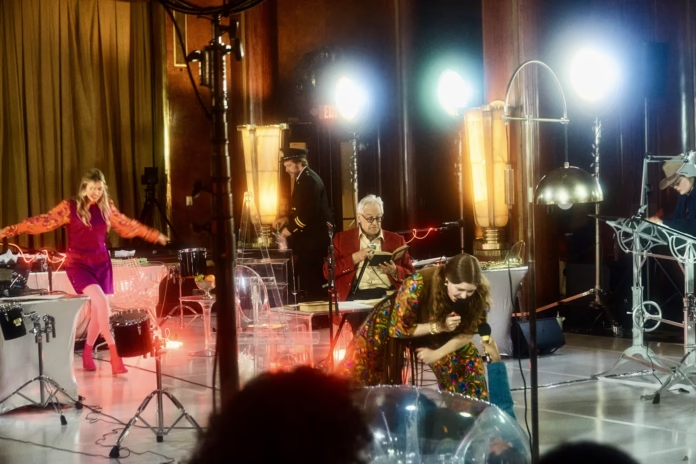We are on a ship at sea. The captain has just died. A new mapmaker has been born unto a library that contains all the maps in the universe. Passengers and crew drift across the sea of time on a voyage without a fixed destination.
Or something like that. The wisps of plot were beside the point in the second-ever staging of Pauline Oliveros and Moira Roth’s The Library of Maps: An Opera in Many Parts, performed aboard the Queen Mary on April 12 and 13. Rather, Long Beach Opera’s production was a wondrous evocation of life as an inscrutable journey that can be beheld as we move along, beheld and rendered but never pinned down.
Though The Library of Maps was the third of four shows in Long Beach Opera’s “ALL OLIVEROS” season, it seems Oliveros’s only role was as guiding spirit (“No score exists for the piece,” LBO tells me, “no musical sketches”), as director/producer James Darrah used a small sampling the two-dozen poems loosely comprising Roth’s libretto to craft a nebulous narrative that unfolded within four movements of largely improvised music with foundations laid by Darrah and musical director Christopher Rountree
Part of the success of The Library of Maps is that it’s impossible to know where those foundations ended and the spontaneous construction began. No portion of the opera seemed to meander (more often than not the bane of even virtuosic improvisation), with all eight performers exercising a discipline that unfailingly served the moment and the whole.
A single mallet strike on a small hand cymbal marked the beginning of first movement, a solitary sound suspended in space until joined by the long intonations of a single voice. Gradually a second cymbal was marched on, a second voice weaving its own notes into growing complexity of overtones. Already the care in the sound design was evident, a dark electronic reverb coloring the natural acoustics of the Queen’s Salon. Think Cocteau Twins trying their hand at Gregorian chant.
A frantic announcement by Darrah (as the Deputy Captain) on crackling loudspeaker propelled us toward the next movement, where we were provided with a partial list of the Library’s holdings (the Lost Map, the Two Street Maps, the Cartographer’s Last Map, the Maps of Walter Benjamin, the Unruly Map of Threads, the Child’s Map of Time . . .), before we ventured into the subsequent movements (the Map of Shadows, the Room of the Mute Woman, the Map of the Sandstorm Desert), where aria, spoken word, and instrumental passages ranging from texturally sedate to percussively frenetic seemed to bring us into dream whose meaning was just beyond our grasp.
Whether singing or playing, interacting with each other or solipsistically holding space, every member of the cast — Darrah, Rountree, M.A. Tiesenga, Catherine Brookman, Paul Pinto, Kathryn Shuman, Peter Kazaras, O-Lan Jones, I-Chin Feinblatt — exquisitely dispatched their duties. And while it might be derelict on the reviewer’s part not to single out this or that performer for condign praise, that can happen when the gestalt sweeps you up. I didn’t always track who was doing what, any more than I tracked the details of Roth’s text. The specifics didn’t matter, in the very best sense.
To say that Darrah and company attended to the performance’s every nuance is not to oversell just how completely The Library of Maps was realized. Equal in quality to Nathan Grater’s sound design was Kaitlin Trimble’s lighting, modulated to maximize the Salon’s plush Art Deco trappings and the silvery sheen of Prairie T. Triveth’s set. Chrisi Karvonides-Dushenko’s costumery provided each character with a striking visual signature that contributed to the gorgeous panoply. Taken all together, the individual elements of The Library of Maps melted into an aesthetic flow beguiling to the analytic faculties. Questions of what it was and how it came to be were subsumed by pure, joyous experiencing.
And as I lingered with many other audience members in the post-show glow an hour after the conclusion of the 75-minute performance, I wanted to experience it all again. Not the kind of thing one feels about opera every day — or in my case, ever. Until now.
“I’ve never really been somebody that wants anyone to walk out of the theater and think, ‘Meh,’” Darrah told SF Gate last month. “I want somebody to be like, ‘That was amazing,’ or ‘I hate you, James!’ It just means you’re hitting a nerve, you’re tapping into a current, you’re on a pulse of something.”
To be sure, since Darrah took the helm in 2020, Long Beach Opera has been more hit-and-miss than under the previous regime, partly because they’ve expanded their range of offerings well beyond what most of us call “opera,” occasionally to decidedly underwhelming effect.
But The Library of Maps shows what they’re capable of when they bring all of their considerable talent and vision to bear on a project, joining 2023’s The Romance of the Rose as one of the four best things they’ve ever done. Amazing indeed.
Long Beach Opera closes their “ALL OLIVEROS” season with the third annual LBO Film Festival, “this year focusing on Pauline Oliveros’ legacy as a queer artist.” At the heart of the two-day event will be the U.S. West Coast premiere of The Nubian Word for Flowers: A Phantom Opera, which “delves into the Nubian diaspora and the life of Lord Kitchener, blending live performance, electronics and moving images to create a dreamlike exploration of Nubian soul and colonial history.” For details, visit LongBeachOpera.org.



